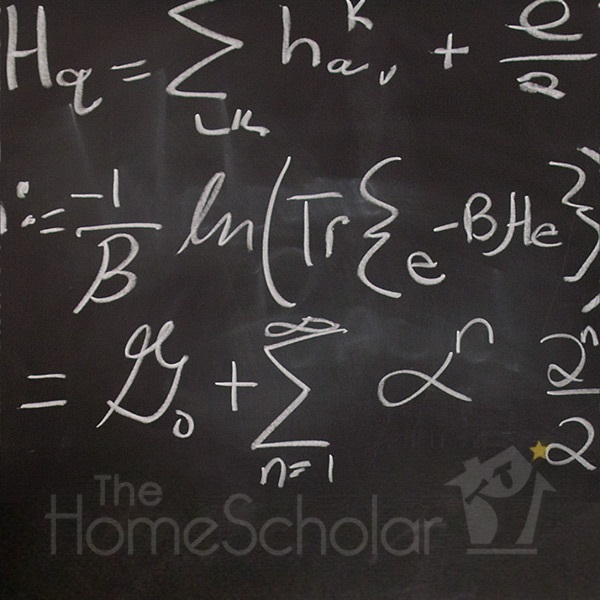So, a question many high school homeschool families ask when planning to teach math is, “what is the order of math classes in high school?” Questions may be as specific as “is algebra 1 or geometry harder?”, “is pre algebra harder than algebra 1?”, “is algebra 2 for 10th grade?”, “is geometry higher than algebra 2?”, “what comes after algebra 2?”, or “what grade do you take geometry?” For most students, what comes first doesn’t matter. The most important thing is that your child is learning math consistently each year.

What is the order of math classes in high school? It may surprise you that the order of math covered doesn’t matter as much as ensuring math is taught for four full years in high school.
A high school transcript should include four credits of math. Four years of math is important because it’s often required for high school graduation. It’s also important because most colleges require a full four years of math. And it’s important to prepare your students for any college or career in the future.
Even if your child already has four or five years of math by the time they start high school, you still want to teach four years of math while they’re in high school (at high school age). However, that doesn’t mean your child has to do four years of upper level math, including calculus. It just means they should continue to work at their own level and keep moving forward every year.
Yes, it’s wonderful to complete calculus in high school, but not everyone is going to get there. Just because they don’t get to calculus doesn’t mean they can’t get into college! Cover math every single year regardless of the level they achieve.
There are two typical math sequences for high school :
Algebra 1 > Geometry > Algebra 2
OR
Algebra 1 > Algebra 2 > Geometry
Some textbooks follow one way, and some follow the other way. They all try to convince you their way is the right way! Mathematically, it doesn’t matter which one comes first, Geometry or Algebra 2, to be honest. However, your child might benefit if they take geometry before 11th grade, to prepare for the PSAT/NMSQT® and SAT®.
Register for my free class and learn the keys to home high school success no matter how challenging the topics (or your teens) can be! The 12 Keys to High School Success Webinar

Just know that, Geometry is completely different from algebra, much like biology is different from chemistry. Kids that hate algebra may love geometry. Introducing geometry in the middle gives kids a break. Geometry class also has some review of Algebra 1 concepts in it. As you balance numbers, you use some of the skills that you learned in Algebra 1. By completing Algebra 1 followed by geometry, your child gets a whole year of Algebra 1 practice before going on to Algebra 2. It can help students who are not secure in their Algebra 1 skills get those skills into their brain before they have to start Algebra 2.
There is quite a bit of geometry included on the PSAT/NMSQT®. In order to have a chance to earn the National Merit Scholarship, your child will have to complete Geometry by 10th grade. But you know, the National Merit Scholarship is only one reason to take the PSAT. Very few students earn the scholarship (only the top 1/2 of 1 percent in the nation). The other purpose for taking the PSAT/NMSQT® is to practice for the SAT®. In other words, the PSAT/NMSQT® has two purposes: for fun, and for profit.
Taking geometry first, when kids are in 10th grade makes sense. It can increase their test scores, thereby increasing financial aid from colleges. Geometry and algebra are quite different skills. But Geometry includes some Algebra 1 skills, so it’s a nice year-long review of algebra, giving kids a chance to really digest and become one with Algebra 1 concepts.
You can learn more about how to homeschool high school math in my article,High School Math without the Moaning.
Click Here to Join my Newsletter!
SAT®, AP®, and CLEP® are trademarks owned by the College Board, which is not affiliated with, and does not endorse, this blog post or The HomeScholar, LLC.
PSAT/NMSQT is a registered trademark of the College Board and the National Merit Scholarship Corporation.


Lee,
I was discussing this very subject this afternoon with 2 moms. The question I asked was, what comes after Algebra I? Both of them said geometry without hesitation. One mom uses Math U See, the other Saxon, but the Saxon mom has 2 that are younger than my daughter, and they will be doing algebra I next year. My daughter really enjoys the geometry part and loves to figure out the surface areas of geometric shapes. (They make my head spin.) So I will probably go the geometry route to help algebra settle in her brain a bit. Thanks for that suggestion. I will look into Jacobs.
We are doing the algebra 1, geometry, algebra 2 route.
My oldest did Alg.1 with Key To Algebra which was VERY good preparation for her then we did Teaching Textbooks for Geometry because she just plain needed a break from Algebraic thinking. The logic and type of thinking required for Geometry was a perfect fit for her, especially since TT is so strong with the logic and proofs (Key to Geometry is not!). She then went to Saxon for Algebra II (her choice out of the many out there) and had her best year ever. She was well prepared for the Algebra, but not burnt out, and she didn’t have to “learn” the geometry while she was also learning the Algebra II.
From all that I have read, the section of the brain that deals with algebraic thinking develops later. For that reason it is usually better to interrupt the Algebra classes with Geometry. Most math teachers that I have spoken with agree that the Algebra I, Geometry, Algebra II route is the best for most students.
We used Video Text Interactive which combines Pre Algebra, Algebra I and Algebra II. We are pretty much through Pre Algebra and Algebra I and now my daughter is totally burnt out on Algebra. So we decided to take a break from Algebra and do Geometry. I think we are going to try Teaching Textbooks because I’ve heard so many of my friends families love it.
I’m going to talk about after homeschooling is over. Geometry’s “4/3 pi this and the other thing” is memorized if the student’s background is algebra 1 or 2. But after calculus 1 those formulas are reasoned through infintesimal slices of shapes, and their limits, not memorized. So if rote memorization causes annoyances that’s one factor.
Depending on how far your homeschooler is going; I have a technical degree and a business one, alg2, geo, trig, calc1-2-3 makes sense from the technical point of view. From the business side I need to be able to describe and aim at a market segment, or control some management metric, and geo and trig and calc are skippable. Statistics could be deeply understood after calculus (and trig identities helps with calculus, and dang! geo helps with trig) or lightly reasoned through, think Millionaire Next Door correlations for the light version. In the light scenario you have M$ Excel do your graphing and heavy lifting for you. If you get into projects that require more you outsource some sort of a mathmatician or matlab ninja.
I like how when thinking about doing adjustments to your high schoolers curricullum you are thinking longer term end results. What a leg up.
I think it also depends on the student. My DD did Algebra 1 in 8th grade and enjoyed it (she loves solving puzzles and mysteries) so for 9th grade she wanted to continue with Advanced Algebra. In 10th grade she did Geometry (lots of proofs!) and in 11th grade Trigonometry. (There was some overlap as she finished some of it before the end of the year so she would start the next level math…you know how homeschoolers are! LOL)(BTW, she used Life of Fred which she loved!)
For 10th grade she took the PSAT “for fun and practice” (did very well) and again in 11th grade (got Natl Merit Commended) and then she took the SAT in spring of her Senior Year and scored 1560. She timed the SAT differently than most students bc she was not going to college immediately after HS and she was determined to go the “one and done” route on the SAT. Plus she was a grade ahead of her public schooled peers anyway.
Lee, you were incredibly instrumental in helping me learn how to prepare my DD for her PSAT/SAT! I learned so much from you! With your wisdom, The College Board resources, and practice books (Barron’s, etc.), my homeschooler had a pain-free testing experience and I felt so equipped to be her guidance counselor.
Now my DD is working on general ed requirements at a local community college while she pursues her passion (Lee is right about the community college environment too–yikes!) and is enjoying her pre-calculus course (mostly a repeat of what she learned thanks to LOF). Homeschooling Works!
Wonderful feedback, Cindi!!
You are so very right. That’s one of the awesome things about homeschooling.
Lee will love reading your kind comment!
Blessings,
Robin
Assistant to The HomeScholar
I did Algebra 1 in 7th grade, and my mom taught me advanced geometry starting from 5th grade. I am learning Algebra 2 over the summer, and I think it is a little too easy for high schoolers. They should be learning more advanced stuff
Hi, Angelina!
Thanks for chiming in! I’m so glad that you had such a great experience with Algebra I and II. Isn’t it beautiful that homeschoolers can work at their own pace and take courses that best fit their individual needs!?
Blessings,
Anita, Assistant to The HomeScholar
WA state does not require 4 years of math for high school graduation.
taken from: https://www.seattleschools.org/academics/college_career_readiness/graduation_requirements
“Mathematics
Credits: 3.0
Required Courses:
– Algebra I
– Geometry
– Algebra II
Note: Students should take Algebra I and Geometry, Algebra 2 or earn credits in OSPI approved equivalent career and technical education (CTE) courses. RCW 28A.230.097 WAC 180-51-068 3”
Same for other districts in the state, the requirement is 3 credits. My child was accepted dual enrollment at a state four year college as an incoming 11th grader having only pre-algebra and Algebra I on her transcript and was not required to take a math placement test for entrance. Seems most important to know what the college of choice is going to require and ensure your child has completed those. The college actually provides a high school diploma, along with the AA degree, for dual enrollment students who complete the two year degree in 11th and 12th grade. I used the local high school requirements as a way to show the appropriate credits on the transcript, so the local college recognizes it as the expected set-up they usually see from the local public school applicants.
Hi CJ,
It’s important to look at the state HOMESCHOOL law, not the public school law.
What you cited was for Seattle school district, not state wide. As homeschoolers in WA, we must follow the Washington Homeschool Law, which doesn’t say how many years of math at all. You can find the state law requirement from Washington Homeschool Organization: https://washhomeschool.org/.
That said, we aren’t just trying to obey the law, we are also trying to educate our children, and prepare them for whatever the future may hold. Many colleges require four years of college, but don’t necessarily need those to be a certain level of math – so business math or consumer math would often be acceptable to those colleges. Because parents can’t be certain exactly where their child will end up going to college, it’s always best to plan on taking four years of math, and always keep the student moving forward in their math abilities. Then if you find out that math is not needed or required, you can make a change to that plan.
That’s why I recommend starting high school with a plan to cover 4 years of math. Sometimes it really IS required for the plans your child has. And planning for 4 years will help you be prepared for anything.
I hope that helps!
Blessings,
Lee
Hi, so I got business math after I finished geometry and I was supposed to get algebra 2. Is this supposed to happen?
Hi Lili,
It may be that Algebra 2 was not a good match for you. For my son who was going toward an engineering degree, we went the more typical route, with Algebra 1 > Algebra 2 > Geometry. However, with my non-math-focused daughter, we went with something less typical (more like what you are doing) because she was working toward a degree in psychology, and that’s what worked for her.
Robin
Assistant to The HomeScholar